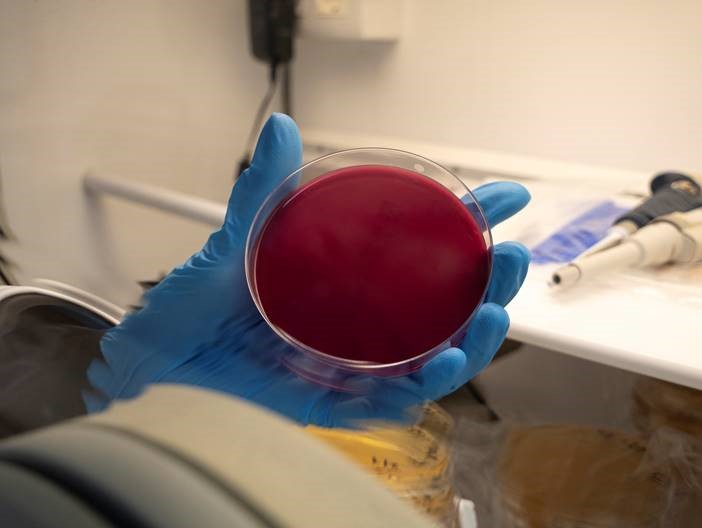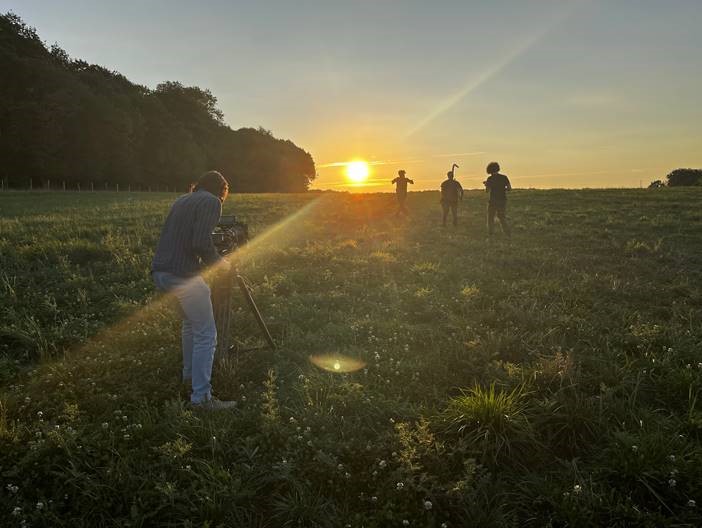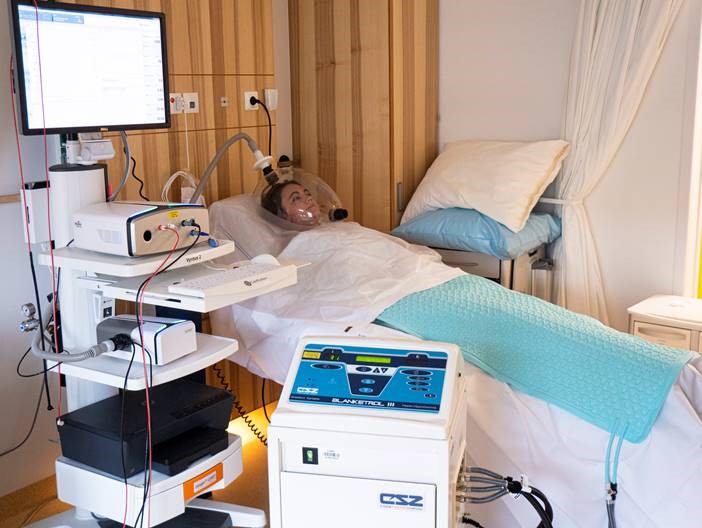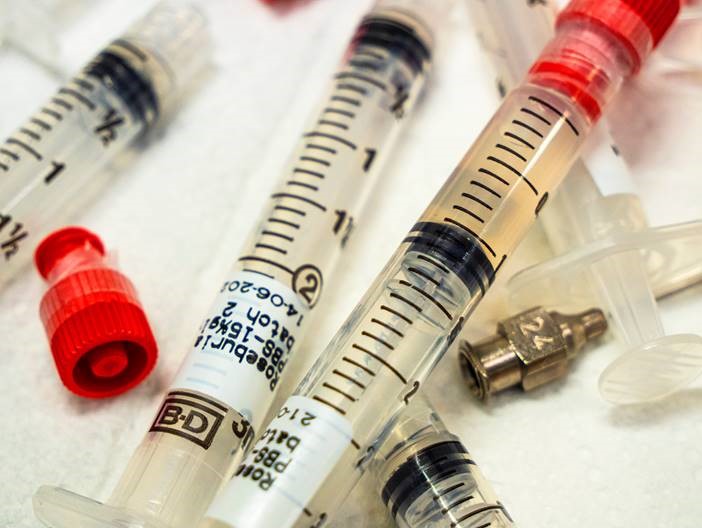For English version, see below
Hoe hebben jullie elkaar ontmoet en hoe kwamen jullie tot het voorstel voor het Mingler Scholarship?
'In 2020 hebben we elkaar ontmoet via een 'speed dating'-evenement in het kader van de ZonMW Bio Art & Design Award. Marion was geïnteresseerd in onderzoek naar het effect van micro-organismen op beweging, daarbij geïnspireerd door de 'dansplaag' van 1518 en hoe deze verband hield met de zogenoemde 'citizen-body'. Patrick raakte hier enthousiast over omdat zijn postdoc Borja Martinez-Tellez onderzoek doet naar het effect van darmbacteriën op spierkracht en lichaamsbeweging. Er was onmiddellijk sprake van een klik, en hoewel dit specifieke voorstel de BAD Award niet won, hebben we de samenwerking voortgezet en voor het Mingler Scholarship het concept omgezet in een film.'
Wat hebben jullie precies gedaan?
'Het idee achter het project was om te meten wat de invloed van lichaamsbeweging was op de darmmicrobiota van Marion. We hebben in juli 2021 eerst een aantal nulmetingen uitgevoerd, in samenwerking met de afdelingen Endocrinologie en Medische Microbiologie van het LUMC. Daarna is Marion begonnen 5 à 6 uur per week te sporten. Tot maart 2022 heeft ze iedere maand fecesmonsters verzameld, die vervolgens vanuit Parijs naar Leiden werden gestuurd voor 16S rRNA-sequencing. Op die manier konden veranderingen in de bacteriële samenstelling worden onderzocht. Deze veranderingen werden vervolgens door Toco Vervisch (een geluidskunstenaar in Parijs) vertaald in geluiden. En op basis hiervan heeft Brandon Masele, een danser en protagonist van de film, een choreografie gemaakt.'

Welke momenten waren cruciaal?
'Het eerste cruciale moment was de eerste keer dat Marion, Patrick en Borja elkaar ontmoetten. Tijdens de ontwikkeling van het project praatten we veel over elkaars onderzoek en de beste manier om uitdrukking te geven aan het oorspronkelijke idee. De resultaten van de 16s RNA-sequencing waren essentieel voor de verdere uitwerking van het concept, evenals de interpretatie van het onderzoek/de geluiden door Brandon Masele.'
Wat zijn voor jullie de belangrijkste resultaten?
'Voor Marion zijn de voltooiing van de film en de gesprekken die daaruit zijn voortgevloeid de belangrijkste resultaten van dit project. We hebben al mogen deelnemen aan twee evenementen (namelijk Brave New World en Night of Discoveries). Hier konden we toelichten wat het gezamenlijke onderzoek achter het project inhield en vertellen over het thema intuïtie dat in de film een rol speelt. Voor Patrick was het belangrijkste resultaat van het project dat hij buiten de geijkte wetenschappelijke paden trad en iets anders produceerde dan een wetenschappelijk artikel. Toen we uiteindelijk de film voor het eerst zagen, raakte ons dat echt.'

Heeft dit project jullie eigen werk beïnvloed?
'Zeker. Het project heeft de belangstelling van Marion voor micro-organismen en de vele verschillende manieren waarop ze het lichaam en het milieu beïnvloeden verder aangewakkerd. Daarom werkt zij momenteel aan nieuwe projecten over deze interacties in uiteenlopende habitats. Het heeft ook haar belangstelling gewekt voor het gebruik van haar eigen lichaam voor creatieve onderzoeksdoeleinden, en de vragen die dit oproept ten aanzien van de interpretatie, het begrip en het gebruik van gegevens door 'citizen-patients'. Voor Patrick heeft dit project zeker wegen geopend om meer maatschappelijk gericht bezig te zijn. Sommige wetenschappers kiezen ervoor om de leek via lezingen te informeren over wetenschappelijk onderzoek, maar anderen doen dit liever via de kunst.'
Meer informatie over het aanvragen van het Mingler Scholarship.
English version of the interview
How did you meet and come to then arrive at a proposal for the Mingler Scholarship?
'In 2020 we met in 2020 through at a ‘“speed dating”’ event, as part of the procedure of the ZonMW Bio Art & Design Award procedure. Marion expressed her interest in researching the impact of microorganisms on movement, inspired by the dancing plague of 1518 and how this correlated to the "‘citizen-body"’. This really excited Patrick, as since his postdoc, Borja Martinez-Tellez, is investigates investigating the impact of gut bacteria on muscle strength and exercise. We evidently had instant chemistry, and although our the specific proposal for the BAD Award did was not winawarded, we continued the our collaboration and for the Mingler scholarship transposed the concept into a film for the Mingler Scholarship.'

Could you give us a brief description of the project?
'The idea behind the project was to measure the impact of exercise on Marion’s the gut microbiota of Marion. After a series of baseline tests, in collaboration with the teams of Endocrinology and Medical Microbiology teams at LUMC in July 2021, Marion started exercising between 5 to or 6 hours per week. She collected faecal samples monthly every month until March 2022, which were sent from Paris to Leiden for 16S rRNA sequencing to evaluate the changes in bacterial composition. These changes were then translated into sounds by Toco Vervisch, a sound artist based in Paris, and his creation formed the basis for creating of a choreography by Brandon Masele, a dancer and the protagonist of the film.'
What would you regard as key moments?
'The first key moment was the initial meeting between Marion, Patrick and Borja. In As we worked through the process of creating the project, we frequently had many discussions about discussed each one another's research and the best ways to portray the initial idea. The results from of the 16sS rRNA sequencing were crucial key to developing the concept further, as was the interpretation of the research/sounds by Brandon Masele.'

What do you consider to be the most important result of this project?
'For Marion, the main outcomes are Completion of the film and the resulting discussions are the main outcomes of this project for Marion. We have already had the chance to participated in two events (i.e., Brave New World and Night of Discoveries) where we to discussed the collaborative research behind the project and the theme of intuition that the movie film touches upon. For Patrick, the main outcome was that he escaped ing his usual scientific box and created ing output other than a scientific paper was as main outcome of the project. Seeing the film, the as end product, for the first time was a truly touching moving experience.'
Has this project influenced your own practices?
'It certainly has. The project has fuelled Marion’s the interest of Marion in microorganisms and their multifaceted influence on the body and the environment, and therefore she is currently working on new projects about these interactions in different habitats. It has also made her interested her in using her own body for creative research purposes to question the interpretation, comprehension understanding and utilizsation of data by citizen-patients. For Patrick, this project certainly opened up new avenues for ‘societal outreach’. While some prefer lectures to inform for laypersons men to be informed about scientific research, others may prefer to do so be informed viathrough art.'
More information on the Mingler Scholarship
Foto's van het proces / Images of the process provided by Marion Lassere.